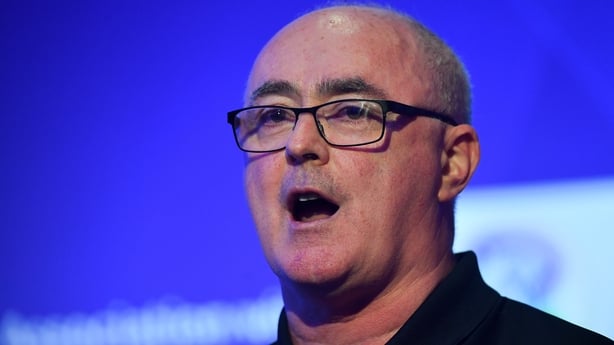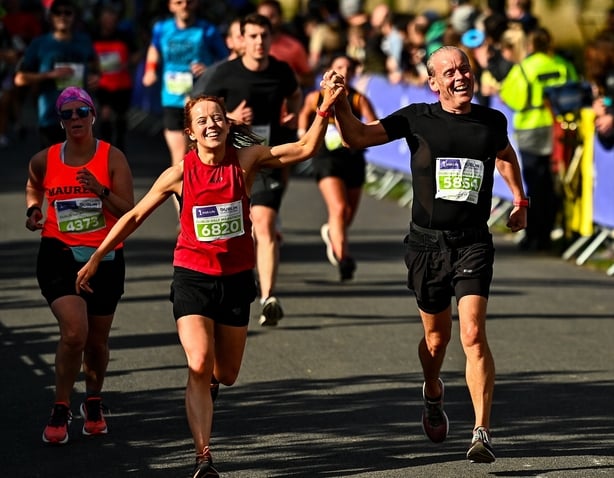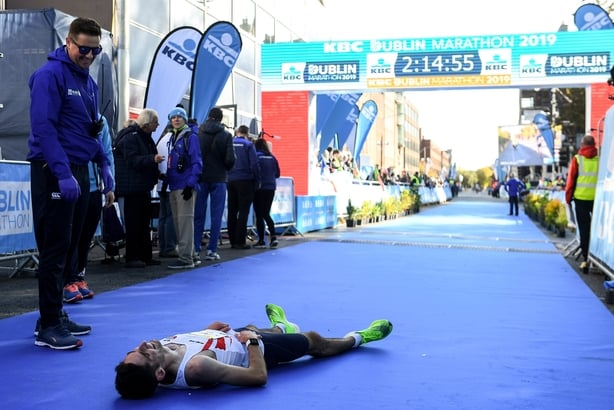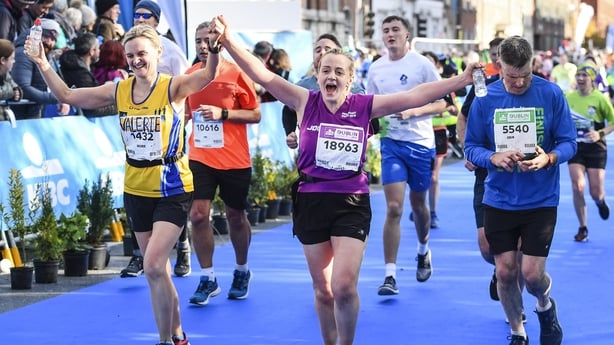When the guts of 25,000 runners gather in Fitzwilliam Square tomorrow morning, the last words they will hear before they embark on a 26.2 mile journey, and final words of encouragement, will come from Liam Moggan.
The Tuam native is well known within the athletics community, and for runners who have previously undertaken the challenge that the Irish Life Dublin marathon represents, his soothing tones have a comforting ring.
"I love the fact that a lot of people know my voice, but not what I look like. It's like being on the radio," he tells RTÉ Sport.
Every year the October bank holiday weekend is marked on his calendar, the days counting down to what is now the fourth biggest marathon in Europe.
Amid all the hustle and bustle on Fitzwilliam Square on race morning - "you can smell the tension, get that whiff of excitement, it’s fantastic" - Moggan is the calming presence, stationed near the start line, his voice projecting as far back as Merrion Square where the participants start gathering.
As a PE teacher at Ardscoil Rís on Griffith Avenue and a member of Raheny Shamrock AC, he was immersed in athletics. More of an 800m runner by trade, Moggan was one of the 2,100 entrants for the inaugural Dublin marathon in 1980.
"Anyone who ran a marathon back then stood out. It was a badge of honour."
The first half a dozen Dublin marathons would be the only six marathons he ever ran.
He knows both sides of the coin. Those six runs could be split down the middle; three were "easy enough" as he had put in the training base, the other three were more of a slog.
Picking up the microphone was never part of the plan, but for years he felt budding runners weren’t being catered to properly.

The lack of a commentator at the Irish Schools Track and Field championships really grated, and eventually, they suggested he take up the role.
"It was never an ego thing. I just wanted to serve, to make the sport and occasion better. I was so committed to it. It was my life," he says.
"I knew all the athletes and I wanted them to be recognised, that people would know their names."
As the millennium closed in, Moggan was asked to take up a similar role for the Dublin marathon. For more than 20 years, he has been the voice of reason as the runners nervously wait for starter’s orders.
"I accept the responsibility the organisers give me. I am the voice on the day, but I am not the person who rolls my sleeves up in the week and months beforehand. I feel a great responsibility to the organising team who are mainly volunteers, firstly, then then the runners."
Moggan is full of praise for Jim Aughney, the unassuming and unflappable race director, who has held the role for 25 years.
Far more concerned with practicality than profile, his calm approach to steering the ship has a ripple effect on the army of volunteers.
You are there with 20,000 people and if you get any ideas about yourself, half an hour later, there is nobody there. It's just a street of jumpers
"Last Saturday night I had a dream," says Moggan. "I stayed in Dublin the night [before] so I didn’t have to travel in. I overslept, woke at 10.30am to find a load of messages on my phone. I had missed the marathon.
"It threw me for the day and I had to ring Jim. He asked me what the weather was like in the dream."
Gazing out at the thousands primed for varying degrees of pain, what does he hope to achieve with the microphone in his hand?
"I don’t need to create excitement. It’s really more a sense of calm. Inform them of things they can’t see.
"It’s a great metaphor for life. You are there with 20,000 people and if you get any ideas about yourself, half an hour later, there is nobody there. It’s just a street of jumpers [all of which go to charity]."
Race day routine follows a well-worn path, part of the "rhythm of our family life".

His three daughters, Aoife, Róisín and Laoise are the support team and the car leaves his Ashbourne home at 5am
As the early officials arrive and the gantries are erected, he meets the same familiar faces on the empty Dublin streets.
Thirty-six months on from the last edition of the race, it is a reminder of those no longer with us. For Moggan, Irish athletics stalwart and long-time volunteer Pat Hooper’s passing makes the occasion more poignant.
The two men shared many arduous runs in the lead-up to the early Dublin marathons and was the perfect sounding board.
"The marathon and Pat were synonymous together. A wonderful man."
The commentator will be ready before the sound system is up and running and then all the preparation – he is ready for if the start time is ever delayed, but that course of action has never been called upon – takes over.
Once the instructions, advice, shoutouts, encouragement and announcements are made, his role is effectively over a little after 9.30am.
A quick family breakfast is fuel for the day before stationing themselves along the final mile, between Northumberland Road and the finish line at Merrion Square.
Having run a personal best of 2 hours 45 minutes - "looking back, I’m happy with that" - Moggan is almost captivated by the elite runners as they fly by.
The athletic grace of those with silverware aspirations is a "sight to behold", yet the finish line is the great level playing field.

"When they cross the line, they look so human, so brittle and broken. They’re able to give everything."
It’s further down the field however where admiration turns to awe.
"By the time you get to the five, six-hour people, you can see it was a massive challenge. They are the people that break your heart.
"You know they are doing it for something deep in themselves, something for a family member. Maybe something they promised, but didn’t deliver every week in training, but they got there.
"I am touched by those people."
The race is almost unrecognisable from the inaugural event in 1980.
Entry numbers have increased year on year since 2009. Two years ago, 35,000 applied for a place though the field is capped at 25,000.
An estimated €9m is raised for charity partners and the run is worth somewhere in the region of €26.5m for the city.

Notwithstanding the steep upward trajectory of the event in recent years, Moggan says the local feel is what sets it apart, with 300,000 spectators expected to line the course.
"I think it’s the greatest day in Dublin. I often say it’s a place of most potential. People are passionate, positive. They are connected, challenged.
"It embodies a lot of the friendliness of Dublin. The Dubs make it, there is a spirit in them. It’s easy for us culchies to give out about them, but there is a wonderful sense of community and place and humour. I think the marathon unveils all of that.
"They really, really embrace it."


